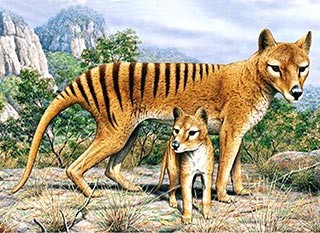
Scientists at work to resurrect Tasmanian tiger, extinct since 1936

Scientists in Australia and the US are working on an ambitious ‘Jurassic Park’-like multi-million dollar project to bring back not a dinosaur but the shy, semi-nocturnal Australian mammal, the Tasmanian tiger, from extinction. If the researchers are successful, the first thylacine is expected to be reintroduced into the wild in 10 years’ time.
The Tasmanian tiger, which is actually a striped carnivorous marsupial, officially known as thylacine, used to be an inhabitant of the Australian bush. But the population started to decline as it was hunted down by people and with the appearance of a wild dog species, dingoes. The last known thylacine named Benjamin died from exposure in 1936 at the Beaumaris Zoo in Hobart, Tasmania. This incident happened, ironically, soon after thylacines were granted protected status.
The science of resurrection
The project, spearheaded by Professor Pask of the University of Melbourne, is being conducted in collaboration with the tech entrepreneur Ben Lamm’s Colossal Biosciences, a US de-extinction firm that uses advanced gene-editing technology to bring back extinct animals like the woolly mammoth (remember Manny from Ice Age?). They are working to bring back the woolly mammoth in an altered form.
The scientists will use advances in genetics, ancient DNA retrieval and artificial reproduction to create the marsupial, according to media reports. Australian and US scientists plan to take stem cells from a living marsupial species with similar DNA, and then use gene-editing technology to “bring back” the extinct species – or an extremely close version of it.
Also read: Cheetahs are coming back to India: The inside story of the homecoming
According to reports, first, the team will construct a detailed genome of the extinct animal and compare it with that of its closest living relative – a mouse-size carnivorous marsupial called the fat-tailed dunnart – to identify the differences.
The living cells from the dunnart will be taken and their DNA will be edited at the places where it differs from the thylacine. In short, the dunnart cell will be engineered to become a Tasmanian tiger cell. Once the team has successfully programmed a cell, the stem cell and reproductive techniques involving dunnarts as surrogates, will “turn that cell back into a living animal.”
Not a new idea
The idea of bringing back the Tasmanian tiger has been around for more than 20 years. In 1999, the Australian museum tried to clone the animal. Also, there have been efforts made ever since to extract or rebuild viable DNA from samples.
Also read: Kerala’s Bird Atlas, Asia’s largest, shows the way in conservation
However, experts are not impressed. They brush off “de-extinction” as a “fairytale science”. Some believe that the team will not be able to exactly recreate the thylacine but instead will end up creating a hybrid animal. Recreating the full genome of a lost animal from DNA, contained in old thylacine skeletons is extremely challenging. In the process, some genetic information can go missing.
It is unlikely the full genome sequence of the extinct species will be fully recreated. There will always be some parts that can’t be changed, say media reports quoting experts. Moreover, scientists feel that it would be a good idea if cutting-edge technology can be deployed to preserve the genetic diversity of the growing number of threatened species around the world, including marsupials.


